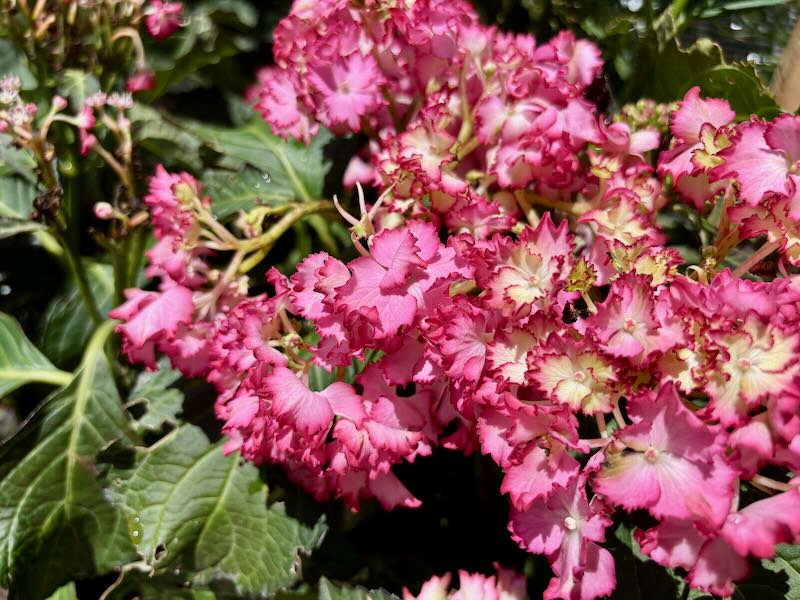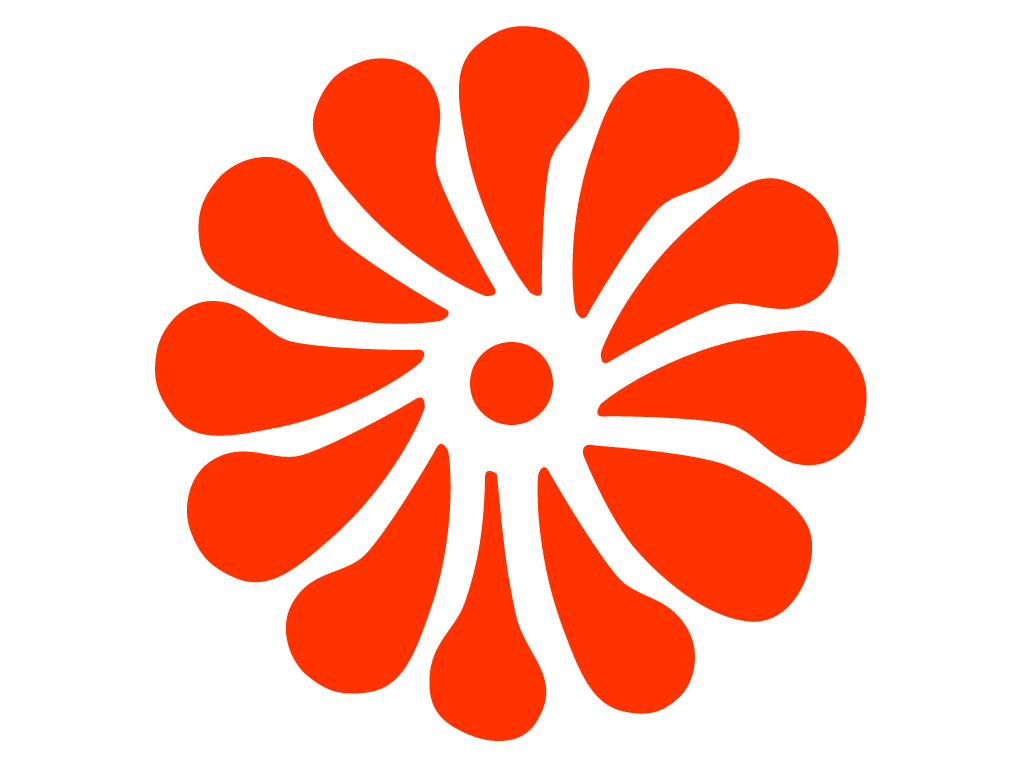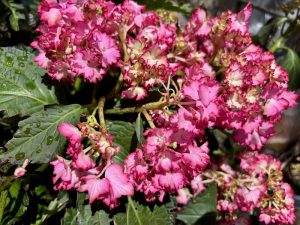Hydrangea macrophylla ‘Hortfire’: compact, reblooming mophead with show-stopping bicolor blooms
Hydrangea macrophylla ‘Hortfire‘ —sold widely as Seaside Serenade® ‘Fire Island’ Hydrangea—is a compact, reblooming Bigleaf Hydrangea that delivers white mopheads edged in rosy red on notably sturdy stems. Gardeners love its tidy, rounded habit (about 0.9–1.2 m tall and wide, or 3–4 ft), its leathery, dark green leaves that flush maroon in spring and fall, and its rare trait among Bigleaf Hydrangeas: flower color that stays true regardless of soil pH. Place it where you want long, reliable color with minimal fuss—small borders, foundation beds, patio pots, and coastal gardens all count.
This is a tetraploid selection in the Hydrangeaceae family, bred for thicker leaves, stronger stems, and compact growth. You get large, long-lasting mopheads that open from chartreuse buds as clean white florets finely edged in deep pink to crimson. As clusters mature, they deepen to saturated pink with elegant green overtones. Because Hydrangea macrophylla ‘Hortfire’ blooms on both old and new wood, you see flowers from late spring and then again through summer into early autumn. In many climates, the show runs from May or June until September or October.
The story and names behind Hydrangea macrophylla ‘Hortfire‘
Breeders at Kolster BV in the Netherlands selected this cultivar, and Monrovia introduced it in North America within the Seaside Serenade® series. The registered cultivar name is ‘Hortfire’ (Plant Patent PP29,058). You’ll see it marketed as Seaside Serenade® Fire Island Hydrangea, Fire Island Hydrangea, and Bigleaf Hydrangea ‘Hortfire’. All sit under the botanical umbrella of Hydrangea (Hydrangeaceae), alongside oakleaf Hydrangea (Hydrangea quercifolia), panicle Hydrangea (Hydrangea paniculata), and mountain hydrangea (Hydrangea serrata).
Hydrangea macrophylla ‘Hortfire’ appearance and size
Expect a multi-stemmed shrub with a rounded, very uniform outline. New leaves emerge with a maroon wash, then mature to glossy, leathery dark green. In autumn, cool nights can bring that maroon back for a second season of foliage interest. Mopheads measure 15–20 cm across (6–8 in) on tough, wind-resistant stems that hold up well in rain. The compact framework typically stays 0.9–1.2 m tall and wide (3–4 ft by 3–4 ft), perfect for massing along a path, flanking a stair, or anchoring a large container.
Flowering season and color performance
Hydrangea macrophylla ‘Hortfire’ starts on old wood in late spring, then pushes new buds on current season growth for a summer repeat. Deadhead promptly and you’ll keep the show going. Cool nights intensify the red edge; warm spells can broaden the pink. Unlike many Bigleaf Hydrangeas, the bicolor effect does not swing to blue on acidic soils because the pigmentation is genetically fixed. That stability simplifies care, especially for gardeners who don’t want to chase color with aluminum sulfate or lime.
Environmental tolerances that make growing easy
This hydrangea thrives in evenly moist, well-drained soil and tolerates coastal exposure, including salty air and steady wind. Strong stems resist flopping in rain. In heat, it appreciates afternoon shade and consistent soil moisture. In cold, it holds buds well with light protection. Plant it in USDA Zones 4–9. In Zones 4–5, protect buds through winter to secure the first flush; in Zones 8–9, shelter from harsh afternoon sun to prevent leaf scorch.
How to Grow Hydrangea macrophylla ‘Hortfire‘
Light
Give it morning sun and afternoon shade for the longest, cleanest display. Aim for 4–6 hours of direct light, ideally before noon. In cool coastal or northern climates, it handles more sun; in hot inland areas, move it to bright, dappled light after midday. Too much shade reduces flowering and stretches stems.
Soil
Plant it in enriched, well-drained soil that holds moisture but never puddles. Loamy ground with plenty of organic matter works best. If you have clay, loosen the bed 30–40 cm deep (12–16 in) and blend in compost with coarse bark fines to improve texture and drainage. If you garden on sand, add compost to boost water-holding capacity. Target a pH in the neutral range; with ‘HORTFIRE’ you don’t need to adjust pH for color.
Watering
Hydrangeas drink more than many shrubs, yet they resent wet feet. Keep the root zone consistently moist, especially during the first growing season. Water deeply so moisture reaches 20–25 cm (8–10 in). In summer, expect a thorough soak one to two times per week in the ground, depending on heat and soil; containers often need water every 1–3 days in hot spells. Always check the top 2–5 cm (1–2 in) of soil; if it feels dry, water. Aim your hose at the base to keep foliage dry and lower disease pressure.
Fertilizing
Feed modestly. In early spring, scratch 2–3 cm (¾–1¼ in) of compost into the surface and water well. If growth looks pale or sparse, apply a slow-release balanced fertilizer labeled for flowering shrubs at label rate. Stop feeding by late summer—August in most regions—so new growth can harden before frost. Avoid heavy nitrogen doses, which push leaves at the expense of flowers.
Planting and spacing
Plant in spring or fall when soil is warm and rains help. Dig a hole twice as wide as the root ball and the same depth. Tease circling roots, set the crown level with the surrounding soil, backfill, and firm gently. Water to settle and mulch. Space plants 0.9–1.2 m apart (3–4 ft) for a continuous hedge; for single specimens or in mixed borders, give 1.2 m (4 ft) of breathing room so air circulates.
Mulching
Add a 5–7 cm layer (2–3 in) of organic mulch such as shredded bark, leaf mold, or compost. Mulch cools roots, evens out moisture, and feeds soil life. Pull mulch back 5–8 cm (2–3 in) from stems to prevent rot.
Pruning
Keep it simple. Because Hydrangea macrophylla ‘Hortfire’ flowers on old and new wood, you don’t need heavy cuts. In early spring, wait for buds to swell, then remove dead, winter-killed, or weak stems right to the base. After the first big flush, you may shorten a few overly long stems to shape. Deadhead promptly by snipping spent clusters back to a strong pair of leaves. Avoid hard pruning after August; you’ll remove next spring’s early buds.
Winter protection
In Zones 4–5, protect old-wood buds to secure that first May–June show. After the ground freezes, pile 10–15 cm (4–6 in) of mulch over the root zone. In windy sites, wrap the shrub loosely with burlap to buffer drying winter winds. And in Zones 6–7, mulch and good siting usually suffice. In Zones 8–9, concentrate on summer protection: afternoon shade and consistent moisture.
Containers
Hydrangea macrophylla ‘Hortfire’ shines in pots. Choose a container at least 40–45 cm (16–18 in) across with generous drainage. Use a high-quality, peat- or coir-based potting mix with added pine bark for structure. Water when the top 2–3 cm (¾–1¼ in) dries; in heat, that can be daily. Feed lightly with a slow-release container fertilizer in spring. In cold regions, wheel the pot into a sheltered, unheated garage after leaf drop, water sparingly through winter, and roll it back out after the last hard freeze.
Hydrangea macrophylla ‘HORTFIRE‘ in garden design and companion planting
This compact shrub solves scale problems where classic Bigleaf Hydrangeas overwhelm. Use three to five plants as a low, flower-rich hedge along a path or terrace. Tuck one on either side of porch steps for symmetry. In mixed borders, its bicolor mopheads make vivid partners for blue hostas, chartreuse heucheras, and lacy astilbes. Underplant with spring bulbs; their leaves fade just as hydrangea foliage fills in. For season-long contrast, pair with evergreen structure—holly (Ilex), sweetspire (Itea), azalea (Rhododendron subg. Azaleastrum)—then thread in summer texture from ferns and Japanese forest grass. In coastal gardens, use ‘HORTFIRE’ with seaside staples like Armeria maritima and Erigeron to soften stonework and boardwalk edges.
Hydrangea macrophylla ‘HORTFIRE’ for cutting and drying
Cut stems early in the day once florets fully open and feel slightly papery—usually midseason. Use sharp snips and plunge stems into warm water. Hydrangeas drink through the stem’s outer tissues, so recut under water if clusters droop. For dried arrangements, let late-season heads age on the plant until they feel leathery, then cut and stand them in an empty vase indoors; they’ll air-dry in 1–2 weeks and hold color for months.
Propagation of Hydrangea macrophylla ‘Hortfire‘
Hydrangea macrophylla ‘Hortfire’ carries U.S. Plant Patent PP29,058. Where plant patent law applies, asexual propagation (cuttings, layering, division) without permission is prohibited for the life of the patent. When and where propagation is legal, softwood cuttings in early summer root easily. Take 10–12 cm (4–5 in) tips from non-flowering shoots, remove lower leaves, dip in a low-dose rooting hormone, and insert into a 1:1 mix of perlite and peat or fine bark. Keep bright but out of direct midday sun and maintain even moisture and high humidity until rooted. Seed does not come true to type, so nurseries propagate clonal stock to maintain the bicolor trait.
Pests and diseases of Hydrangea macrophylla ‘Hortfire’
Healthy plants in the right site resist most problems. Still, scout regularly so you can act early.
Leaf spots (Cercospora, anthracnose) show up as tan to purple lesions, especially after warm, wet spells. Improve airflow, water the soil rather than the leaves, and remove the worst affected foliage. Powdery mildew appears as a white film in still, humid shade; morning sun and space between plants make the best “spray.” If needed, use a labeled fungicide early in an outbreak.
Aphids and whiteflies cluster on tender growth and the undersides of leaves. Start with a strong blast of water. Follow with insecticidal soap if populations persist. Spider mites favor drought-stressed container plants; keep pots watered and mist the foliage in the morning during heat waves. Scale insects may settle on older stems; prune out the worst and use a summer oil on crawlers if necessary.
Deer browse hydrangeas in many regions. Where pressure runs high, add physical barriers in spring and plant ‘deer-wise’ companions nearby to reduce traffic. Slugs and snails can nick new leaves in wet springs; hand-pick at dusk, or deploy traps and copper barriers if needed.
Root problems almost always trace back to soggy soil. If leaves wilt despite moist ground, check for poor drainage and correct it. Raise the bed, add coarse material, or move the shrub after leaf drop to a better spot.
Hydrangea macrophylla ‘Hortfire’ care calendar
Late winter to early spring: As buds swell, remove dead wood and winter-killed tips. Topdress with compost. Refresh mulch. In cold zones, wait to remove burlap protection until deep freezes pass.
Late spring: Enjoy the first flush on old wood. Water consistently if rains fail. Deadhead as clusters fade to encourage new flower trusses on current growth.
Summer: Hold even moisture and afternoon shade in hot, inland sites. Feed lightly if foliage pales. In containers, water whenever the top 2–3 cm (¾–1¼ in) dries.
Early autumn: Allow later blooms to age on the plant if you plan to cut for drying. Reduce or stop feeding. Keep soil moisture steady going into leaf drop.
Late autumn to early winter: In Zones 4–5, mulch the root zone 10–15 cm deep (4–6 in) and wrap loosely with burlap in wind-exposed sites. In mild climates, a fresh blanket of mulch is enough.
Common mistakes and how to fix them
Planting in full, all-day sun in hot climates often scorches leaves and shortens bloom life. Move the shrub to a site with morning sun and afternoon shade. Over-pruning removes flower buds. If you cut hard by mistake, don’t panic; ‘Hortfire’ still reblooms on new wood later in summer. Starving or overfeeding causes problems too: pale leaves and small clusters suggest poor nutrition, while lush leaves with few blooms point to excess nitrogen. Adjust your feeding accordingly.
Container stress shows as sudden wilt by midday. Pots heat up and dry out fast; choose a larger, lighter-colored container, use a barky, moisture-retentive mix, and water deeply before the day’s heat. Chronic leaf spots or mildew usually trace to crowded, shaded sites with overhead watering. Space plants properly, water at the base, and let the morning sun dry the leaves.
Where Hydrangea macrophylla ‘Hortfire’ works best
Use this compact shrub anywhere you want high-impact flowers without the sprawl of classic mopheads. Line a front walk with a low hedge; anchor a courtyard bed; lift an all-green foundation planting; or fill a large urn on the patio with one perfectly rounded plant. In coastal gardens, let its strong stems and salt-tolerant leaves ride out breezes that flatten floppier hydrangeas. However, in small city yards, combine it with boxwood balls and shade-tolerant perennials for a modern, easy-care mix. In cottage borders, its crisp white-and-rose flowers pair beautifully with foxglove, campanula, and lady’s mantle.
Final take
Plant Hydrangea macrophylla ‘Hortfire’ where it sees morning sun and afternoon shade, set it in rich, well-drained soil, and keep the root zone evenly moist. Feed modestly in spring, deadhead to extend the show, and prune only to clean and shape. Protect buds in the coldest zones and give it shade in the hottest. Do those few things and this compact, reblooming Bigleaf Hydrangea will reward you with months of luminous bicolor mopheads, strong stems that stay upright in weather, and handsome foliage that brings color in more than one season.



